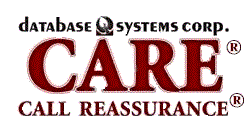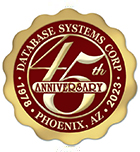|
|



Voice Broadcast Technology
 Voice broadcasting (also refered to as phone broadcasting or voice message broadcasting) is a mass communication technique that sends pre-recorded phone messages to hundreds to thousands of call recipients employing a computer phone system.
Voice broadcasting (also refered to as phone broadcasting or voice message broadcasting) is a mass communication technique that sends pre-recorded phone messages to hundreds to thousands of call recipients employing a computer phone system.
Database Systems Corp. (DSC) is a leading voice broadcast technology company and provides message broadcasting applications to a wide variety of clients and industries. Since 1978, DSC has been providing computer related solutions including software applications and computer systems.
The Latchkey Kids calling program utilizes this advanced technology to contact home alone children enrolled in our CARE (Call Reassurance) program. The DSC voice broadcasting technology calls latchkey children based upon the schedules specified by their parents or guardians. Voice broadcast technology detects answer machines and determines if the call was successfully acknowledged by the child. This technology likewise is used to contact parents.
Contact DSC to learn more about our CARE latchkey kids calling service with integrated voice message broadcasting technology.
Voice Broadcasting and Latchkey Child Calling
 The Latchkey Kids calling program uses voice broadcasting to call children on the days and at the times specified by the child's guardian. When the child picks up the phone, the CARE application employs an IVR program that plays a recorded
phone greeting (sample). The latchkey child is instructed to "Press 1" to acknowledge the call and to indicate that they are OK. If the child is in need of assistance, the CARE program prompts them to call 911 in an emergency or to "Press 3" for a non-emergency. In the latter case, the CARE voice broadcast program sends an alert message to the Contact(s) that the child needs assistance.
The Latchkey Kids calling program uses voice broadcasting to call children on the days and at the times specified by the child's guardian. When the child picks up the phone, the CARE application employs an IVR program that plays a recorded
phone greeting (sample). The latchkey child is instructed to "Press 1" to acknowledge the call and to indicate that they are OK. If the child is in need of assistance, the CARE program prompts them to call 911 in an emergency or to "Press 3" for a non-emergency. In the latter case, the CARE voice broadcast program sends an alert message to the Contact(s) that the child needs assistance.
If after several attempts the child does not answer the phone or acknowledge the call, CARE will automatically call the designated Contact. The CARE voice broadcast program and the IVR associated with this campaign plays an alert message (sample) and sends an email alert.
These alerts must be acknowledged using the same IVR technology stating "To acknowledge receiving this alert notification, Press 1".
Types of Voice Broadcasting Programs
Database Systems Corp. provides many different types of custom message broadcast programs for its clients. Here are a few of the more common calling types of voice broadcast programs that can be performed using our voice message broadcasting phone systems and voice broadcasting services.
- Simple Voice Broadcasting
Simple voice broadcasting is a calling program that dials numbers maintained within a phone list and plays a simple recorded message. This message can be delivered either to an individual, an answering machine, or both. No operator is needed. The call recipient simply listens to the voice message and hangs up.
This technique is useful when providing information or announcing an event, providing a reminder, or requesting an action from the contacted individual.
A different message can be played to an answering machine versus and individual.
- Voice Broadcasting and Touchphone (DTMF) Response
 Voice broadcasting with touchphone technique expands the prior call method by playing a recording that provides the contacted individual with a menu from which to select different options. Using keypad responses such as "Press 1 for...", the choices could include obtaining additional information, being removed from the call list, leaving a voice message, or terminating the call.
A different message can be left on an answering machine or the answering machine could be ignored completely. Although more complex than the prior call types, this form of voice messaging does not require that an agent be available to handle this call.
Voice broadcasting with touchphone technique expands the prior call method by playing a recording that provides the contacted individual with a menu from which to select different options. Using keypad responses such as "Press 1 for...", the choices could include obtaining additional information, being removed from the call list, leaving a voice message, or terminating the call.
A different message can be left on an answering machine or the answering machine could be ignored completely. Although more complex than the prior call types, this form of voice messaging does not require that an agent be available to handle this call.
- Voice Broadcasting and "Press Through" Call Transfer
The voice broadcast press through method is similar to the prior voice messaging technique but with the option to transfer the call to a third party. Again, using keypad (DTMF) responses the contacted individual can request that the call be transferred to an outside agent. The phone system dials another number and when contact is made with the third party or different phone system, the call is transferred.
This is effective when the transfer party or organization is remote or not directly connected with your phone system and center.
Voice Broadcast Information
Contact DSC to learn more about our CARE home alone children calling service and phone systems.
|
|




 Voice broadcasting (also refered to as phone broadcasting or voice message broadcasting) is a mass communication technique that sends pre-recorded phone messages to hundreds to thousands of call recipients employing a computer phone system.
Voice broadcasting (also refered to as phone broadcasting or voice message broadcasting) is a mass communication technique that sends pre-recorded phone messages to hundreds to thousands of call recipients employing a computer phone system.
 The Latchkey Kids calling program uses voice broadcasting to call children on the days and at the times specified by the child's guardian. When the child picks up the phone, the CARE application employs an
The Latchkey Kids calling program uses voice broadcasting to call children on the days and at the times specified by the child's guardian. When the child picks up the phone, the CARE application employs an  Voice broadcasting with touchphone technique expands the prior call method by playing a recording that provides the contacted individual with a menu from which to select different options. Using keypad responses such as "Press 1 for...", the choices could include obtaining additional information, being removed from the call list, leaving a voice message, or terminating the call.
A different message can be left on an answering machine or the answering machine could be ignored completely. Although more complex than the prior call types, this form of
Voice broadcasting with touchphone technique expands the prior call method by playing a recording that provides the contacted individual with a menu from which to select different options. Using keypad responses such as "Press 1 for...", the choices could include obtaining additional information, being removed from the call list, leaving a voice message, or terminating the call.
A different message can be left on an answering machine or the answering machine could be ignored completely. Although more complex than the prior call types, this form of